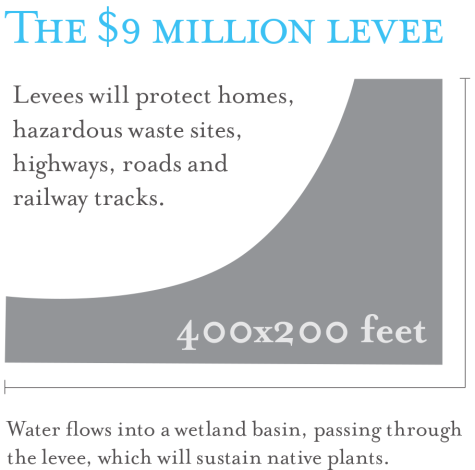$9 million levee project begins in East Bay
November 19, 2015

The threat of rising sea levels inspired a new experimental project that is underway at San Lorenzo’s recently updated Oro Loma Wastewater Treatment Plant. A special event to introduce the project to the public was held on Saturday.
More than 200 people came to the Oro Loma Sanitary District’s plant to learn about the new $9 million levee project at the event, hosted by the Oro Loma Plant and Save the Bay, a volunteer nonprofit. Funding for the project was provided by Oro Loma and Castro Valley Sanitary Districts and a $2.1 million grant from the Integrated Regional Water Management Program.
Project manager and civil engineer, Jason Warner, along with other scientists gave several presentations to the crowd and explained how the marsh plain could protect the coastline from extreme weather, acting as a natural buffer.
The levee project mimics a wetland ecosystem — water will first flow through a wetland basin, through the levee, which will sustain native plants, act as a filter and slow down waves, according to San Jose Mercury News.[mks_pullquote align=”left” width=”300″ size=”24″ bg_color=”#ffffff” txt_color=”#528cbf”]”Responding to sea level rise in an environmentally friendly way is a decent win” -Warner said[/mks_pullquote]
The project is being installed and managed by the Oro Loma Sanitary District in conjunction with UC Berkeley. If successful, the experiment will demonstrate that the natural horizontal levee design will thrive on the wastewater used to irrigate it, and that the natural environment it creates will become a valuable and natural eco-system that will benefit native animals and fauna. The native plants used for the initial planting, were chosen for their ability to process and neutralize potentially damaging nitrogen and phosphorus from the wastewater.
Levees such as these could potentially help protect crucial infrastructure at the bay’s edge, including our 10 existing waste water purification sites, thousands of homes, dozens of hazardous waste sites, highways, roads and railway tracks; all at risk from an anticipated sea rise of 15 to 55 inches over the next 50 to 100 years, due to global warming, according to the Oro Loma Sanitary District website.
The Oro Loma Wastewater Treatment and Purification Plant serves several communities, including San Lorenzo and parts of unincorporated San Leandro and Castro Valley. Water biologists from the plant have worked with scientists from UC Berkeley and members from Save The Bay coalition on the new experimental horizontal levee.
The initial 400 by 200 foot levee is a design developed by coastal ecologist and botanist, Dr. Peter Baye and his team from UC Berkeley.
They seek to create a terrestrial, not tidal habitat, modeled after natural environments once found all over the bay’s edge.
“Responding to sea level rise in an environmentally friendly way is a decent win; but it can be a grand slam if it succeeds in addressing the water quality, flooding and habitat problems we face on our shorelines all at once,” Warner said.
The levee design will also serve as a reservoir for emergency sewage overflows and will protect the bay from sewage pollution from occurrences like those at Marin Country’s Sausalito-Marin water treatment plant in the past years, which were responsible for dumping millions of gallons of raw sewage into the bay.

This new concept was proposed in 2012, but was only begun earlier this year. The public was invited to tour the entire water-plant, including the native plant beds and the outlying area containing the site and the infrastructure of the new levee. The project’s expansion will require overcoming ecologic and economic hurdles currently posed by regulatory issues and funding. Volunteers from Save the Bay have already begun planting 70,000 native plants selected by plant ecologists for their ability to grow and adapt in this environment.
The plants will become an important part of the habitat and will support the bay’s existing eco-system of birds, mammals and insects, crucial to a healthy bio-system. If the plantings survive and the experiment is successful, the marsh plain area at the plant will be increased at a later date. The plan would also be extended to other parts of the San Francisco Bay coastline as well. It seems that everyone could be a winner if this concept of “sustainability meets practicality” does well.















